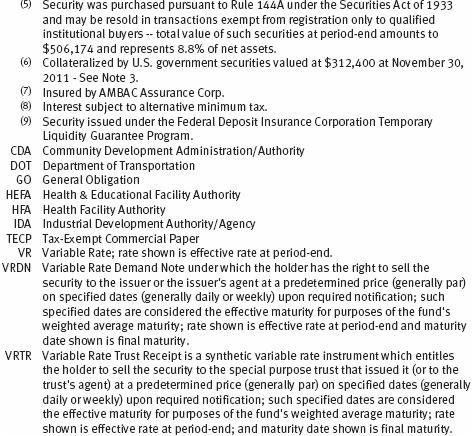UNITED STATES
SECURITIES AND EXCHANGE COMMISSION
Washington, D.C. 20549
FORM N-CSR
CERTIFIED SHAREHOLDER REPORT OF REGISTERED
MANAGEMENT INVESTMENT COMPANIES
Investment Company Act File Number: 811-2603
| T. Rowe Price Prime Reserve Fund, Inc. |
|
| (Exact name of registrant as specified in charter) |
| |
| 100 East Pratt Street, Baltimore, MD 21202 |
|
| (Address of principal executive offices) |
| |
| David Oestreicher |
| 100 East Pratt Street, Baltimore, MD 21202 |
|
| (Name and address of agent for service) |
Registrant’s telephone number, including area code: (410) 345-2000
Date of fiscal year end: May 31
Date of reporting period: November 30, 2011
Item 1. Report to Shareholders
| Prime Reserve Fund | November 30, 2011 |

The views and opinions in this report were current as of November 30, 2011. They are not guarantees of performance or investment results and should not be taken as investment advice. Investment decisions reflect a variety of factors, and the managers reserve the right to change their views about individual stocks, sectors, and the markets at any time. As a result, the views expressed should not be relied upon as a forecast of the fund’s future investment intent. The report is certified under the Sarbanes-Oxley Act, which requires mutual funds and other public companies to affirm that, to the best of their knowledge, the information in their financial reports is fairly and accurately stated in all material respects.
REPORTS ON THE WEB
Sign up for our E-mail Program, and you can begin to receive updated fund reports and prospectuses online rather than through the mail. Log in to your account at troweprice.com for more information.
Manager’s Letter
Fellow Shareholders
The Federal Reserve kept short-term interest rates extremely low in the six-month period ended November 30, 2011, and central bank officials pledged to keep them low until at least mid-2013 to support the weak U.S. economic recovery. Like many other money market funds, the T. Rowe Price Prime Reserve Fund continued to offer investors principal stability and liquidity, albeit with yields and total returns barely above 0%.
ECONOMY AND INTEREST RATES
Although economic growth in 2011 has been less than robust, the U.S. economy in the last few months has held up better than many expected, given the intensifying European sovereign debt crisis and the strong likelihood that a European recession is beginning. U.S. gross domestic product (GDP) in the third quarter was initially measured to be growing at an annualized rate of 2.5%, which eased lingering fears that the economy would experience a double-dip recession. However, it was later revised down to 2.0%, suggesting that the recovery is fragile. With the housing market depressed, national unemployment above 8.5%, and consumers constrained somewhat by elevated commodity prices and a decline in real wages this year, the economy could be hurt if the eurozone situation gets worse.
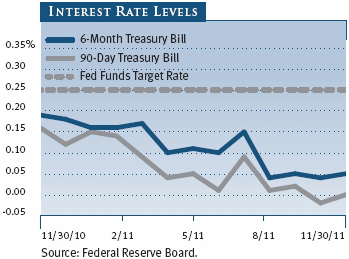
Despite the end of the Fed’s second round of quantitative easing (or QE2) in June and Standard & Poor’s downgrade of the U.S. government’s long-term credit rating from AAA to AA+ in August, intermediate- and long-term Treasury interest rates fell sharply in the last six months, approaching historic lows amid fears of a new economic downturn. To support the economy, the Fed kept the fed funds target rate—a benchmark for money market interest rates—in the 0.00% to 0.25% range established in late 2008 and indicated that it would likely keep short-term rates low until at least mid-2013. The Fed also unveiled new attempts to stimulate the economy in late September, including a plan to purchase $400 billion of intermediate- and long-term Treasury securities through June 2012 and sell an equal amount of Treasuries maturing in three years or less.
PERFORMANCE COMPARISON
Your fund and its Lipper peer group average each returned 0.01% in the six-month period ended November 30, 2011. Like many of its peers, T. Rowe Price has voluntarily waived all or a portion of the management fee it is entitled to receive from the fund in an effort to maintain a 0% or positive net yield for the fund.
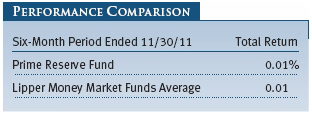
While short-term performance comparisons in this near-zero interest rate environment are difficult, the fund’s 5- and 10-year returns have been competitive and have placed it in the top quartile of all taxable money funds. Based on cumulative total return, Lipper ranked the Prime Reserve Fund 87 of 269, 88 of 254, 55 of 234, and 44 of 191 money market instrument funds for the 1-, 3-, 5-, and 10-year periods ended November 30, 2011, respectively. Results will vary for other time periods. Past performance cannot guarantee future results.
PORTFOLIO REVIEW
Money market funds continue to operate in the most challenging investment environment they have faced since their introduction some 40 years ago. Investment rates and therefore shareholder income continue to be held near zero as the Fed’s 0% interest rate policy enters its fourth year. The looming risk of sovereign default in Europe has redrawn the investment landscape in which many funds operate, and lately, even the quality of otherwise super-safe U.S. Treasury securities has been drawn into question by the continuing debt ceiling drama in Washington. Despite the challenges, investors continue to demonstrate their preference for the safety and liquidity that money market funds provide as part of an overall portfolio strategy.
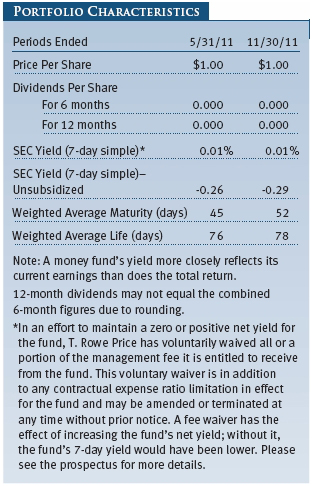
A general theme that has permeated the money markets for some time is the diminishing supply of high-quality investment options. The federal debt limit and the Treasury’s focus on issuing longer-term securities more than shorter-term securities have reduced the outstanding supply of Treasury bills. A slack economy has seriously reduced the funding needs of U.S. corporations and therefore the supply of commercial paper and asset-backed commercial paper. Finally, with the challenges facing the eurozone, money funds have significantly decreased their investments in European banks.
Demand for risk-free investments, coupled with diminished supply, has left Treasury bill rates near 0.00%. Three-month bills averaged a yield of 0.01% over the last six months, but at times, increased market fears have seen bills trade at or below 0.00%. Agency discount notes—increasingly viewed as near-substitutes for Treasury debt—averaged yields of 0.05% for three-month maturities. Bank funding rates have become even more tiered over the past six months as investors moved away from the perceived risks in Europe in favor of less risky banking systems in Canada, Australia, and New Zealand. LIBOR funding rates—a measure of the rates banks charge one another—generally moved higher in the last six months, rising from 0.25% at the end of May to 0.53% at the end of November. In a sign of market stress, however, actual rates varied among individual bank issuers by as much as 20 to 25 basis points, depending upon the bank’s country of domicile and the issuer’s perceived credit strengths and risk exposures. (One hundred basis points equal one percentage point, or 1.00%.) Corporate commercial paper remains in very high demand as investors shy away from financials; issuers can command rates as low as 0.15% for a three-month borrowing period. Municipal seven-day yields have moved in a narrow range, averaging about 0.12% over the period.
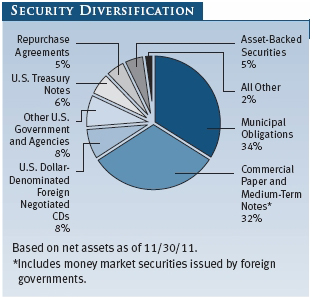
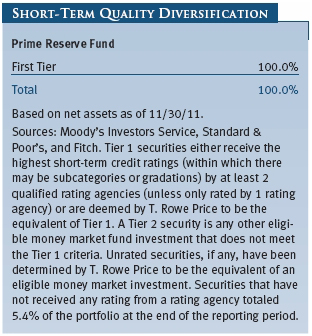
Our investment strategy remains dominated by the quest for quality and safety. We remain comfortable with interest rate risk—in other words, the risk that the value of our holdings will decline due to a sudden rise in interest rates—given the Fed’s intention not to raise rates until at least mid-2013. We are highly sensitive to credit risk, however, especially among financial names and particularly those issuers domiciled in Europe. We have been reducing exposure to unsecured European financial names throughout the period, and that exposure is now less than 4% of the portfolio and invested only in issuers in which we have the highest conviction. Given the unresolved nature of the crisis in Europe, we expect to continue eliminating positions tied to Europe over the coming months. We continue to favor Canadian and Australian bank names in the portfolio. U.S. municipal debt represented about one-third of the portfolio at the end of November. More recently, as LIBOR rates have increased, we have found some opportunities in receivables-backed securities. Treasury and agency debt accounted for more than 10% of the portfolio at the end of our reporting period.
OUTLOOK
We remain quite concerned about events unfolding in Europe and the failure of the Congressional deficit-reduction “super committee” to agree on federal budget cuts over the next decade. Unfortunately, with rates unlikely to rise until the Fed is confident about the economic recovery, shareholders will likely continue to see returns near 0% for the foreseeable future. In the meantime, our investment focus remains on quality, stability of principal, and liquidity.
Respectfully submitted,

Joseph K. Lynagh
Chairman of the fund’s Investment Advisory Committee
December 13, 2011
The committee chairman has day-to-day responsibility for managing the portfolio and works with committee members in developing and executing the fund’s investment program.
RISKS OF INVESTING IN MONEY MARKET SECURITIES
Since money market funds are managed to maintain a constant $1.00 share price, there should be little risk of principal loss. However, there is no assurance the fund will avoid principal losses if fund holdings default or are downgraded or if interest rates rise sharply in an unusually short period. In addition, the fund’s yield will vary; it is not fixed for a specific period like the yield on a bank certificate of deposit. An investment in the fund is not insured or guaranteed by the Federal Deposit Insurance Corporation (FDIC) or any other government agency. Although a money market fund seeks to preserve the value of your investment at $1.00 per share, it is possible to lose money by investing in it.
GLOSSARY
Fed funds target rate: The interest rate charged on overnight loans of reserves by one financial institution to another in the United States. The Federal Reserve sets a target federal funds rate to affect the direction of interest rates.
Gross domestic product: The total market value of all goods and services produced in a country in a given year.
LIBOR: The London Interbank Offered Rate is a taxable money market benchmark.
Lipper averages: The averages of available mutual fund performance returns for specified time periods in categories defined by Lipper Inc.
SEC yield (7-day unsubsidized simple): A method of calculating a money fund’s yield by annualizing the fund’s net investment income for the last seven days of each period divided by the fund’s net asset value at the end of the period. Yield will vary and is not guaranteed.
Weighted average life: A measure of a fund’s credit quality risk. In general, the longer the average life, the greater the fund’s credit quality risk. The average life is the dollar-weighted average maturity of a portfolio’s individual securities without taking into account interest rate readjustment dates. Money funds must maintain a weighted average life of less than 120 days.
Weighted average maturity: A measure of a fund’s interest rate sensitivity. In general, the longer the average maturity, the greater the fund’s sensitivity to interest rate changes. The weighted average maturity may take into account the interest rate readjustment dates for certain securities. Money funds must maintain a weighted average maturity of less than 60 days.
Performance and Expenses
This chart shows the value of a hypothetical $10,000 investment in the fund over the past 10 fiscal year periods or since inception (for funds lacking 10-year records). The result is compared with benchmarks, which may include a broad-based market index and a peer group average or index. Market indexes do not include expenses, which are deducted from fund returns as well as mutual fund averages and indexes.
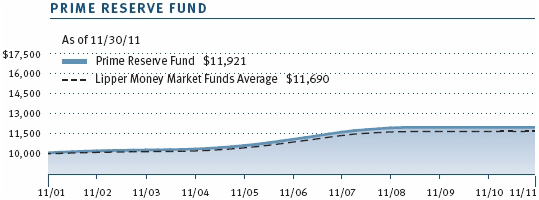

As a mutual fund shareholder, you may incur two types of costs: (1) transaction costs, such as redemption fees or sales loads, and (2) ongoing costs, including management fees, distribution and service (12b-1) fees, and other fund expenses. The following example is intended to help you understand your ongoing costs (in dollars) of investing in the fund and to compare these costs with the ongoing costs of investing in other mutual funds. The example is based on an investment of $1,000 invested at the beginning of the most recent six-month period and held for the entire period.
Actual Expenses
The first line of the following table (“Actual”) provides information about actual account values and expenses based on the fund’s actual returns. You may use the information on this line, together with your account balance, to estimate the expenses that you paid over the period. Simply divide your account value by $1,000 (for example, an $8,600 account value divided by $1,000 = 8.6), then multiply the result by the number on the first line under the heading “Expenses Paid During Period” to estimate the expenses you paid on your account during this period.
Hypothetical Example for Comparison Purposes
The information on the second line of the table (“Hypothetical”) is based on hypothetical account values and expenses derived from the fund’s actual expense ratio and an assumed 5% per year rate of return before expenses (not the fund’s actual return). You may compare the ongoing costs of investing in the fund with other funds by contrasting this 5% hypothetical example and the 5% hypothetical examples that appear in the shareholder reports of the other funds. The hypothetical account values and expenses may not be used to estimate the actual ending account balance or expenses you paid for the period.
Note: T. Rowe Price charges an annual account service fee of $20, generally for accounts with less than $10,000 ($1,000 for UGMA/UTMA). The fee is waived for any investor whose T. Rowe Price mutual fund accounts total $50,000 or more; accounts employing automatic investing; accounts electing to receive electronic delivery of account statements, transaction confirmations, prospectuses, and shareholder reports; accounts of an investor who is a T. Rowe Price Preferred Services, Personal Services, or Enhanced Personal Services client (enrollment in these programs generally requires T. Rowe Price assets of at least $100,000); and IRAs and other retirement plan accounts that utilize a prototype plan sponsored by T. Rowe Price (although a separate custodial or administrative fee may apply to such accounts). This fee is not included in the accompanying table. If you are subject to the fee, keep it in mind when you are estimating the ongoing expenses of investing in the fund and when comparing the expenses of this fund with other funds.
You should also be aware that the expenses shown in the table highlight only your ongoing costs and do not reflect any transaction costs, such as redemption fees or sales loads. Therefore, the second line of the table is useful in comparing ongoing costs only and will not help you determine the relative total costs of owning different funds. To the extent a fund charges transaction costs, however, the total cost of owning that fund is higher.
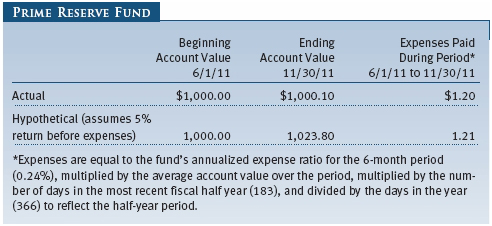


Unaudited
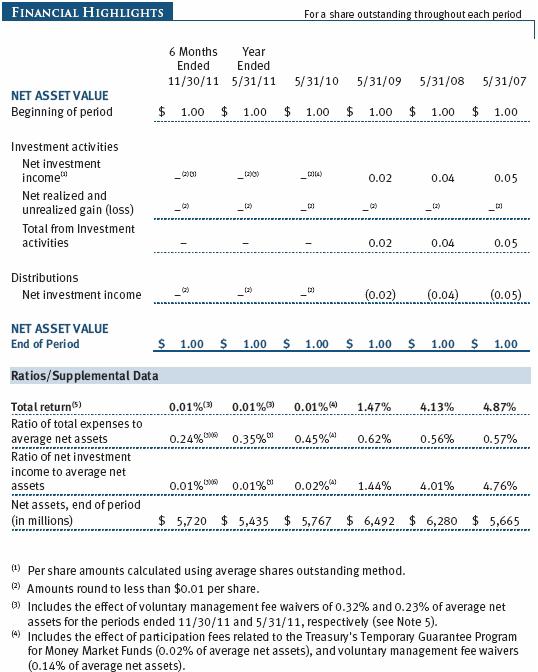
The accompanying notes are an integral part of these financial statements.
Unaudited
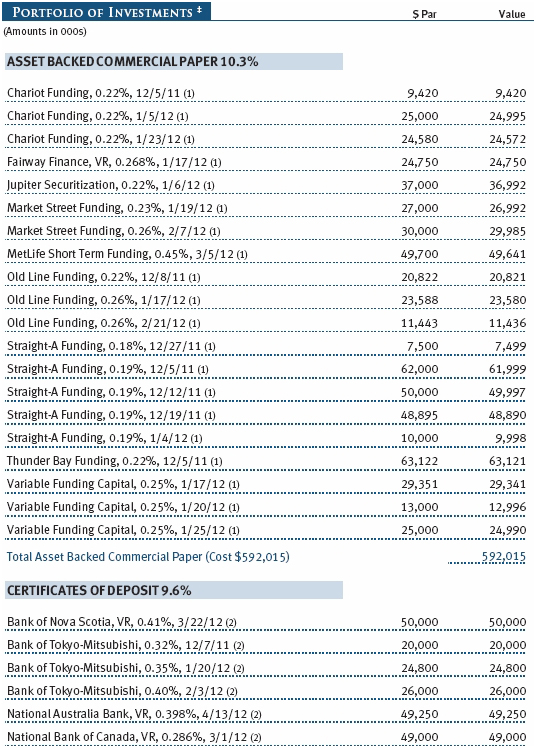
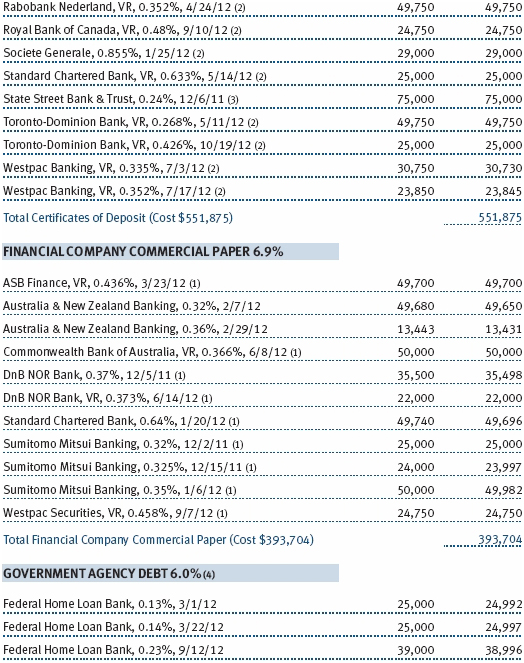


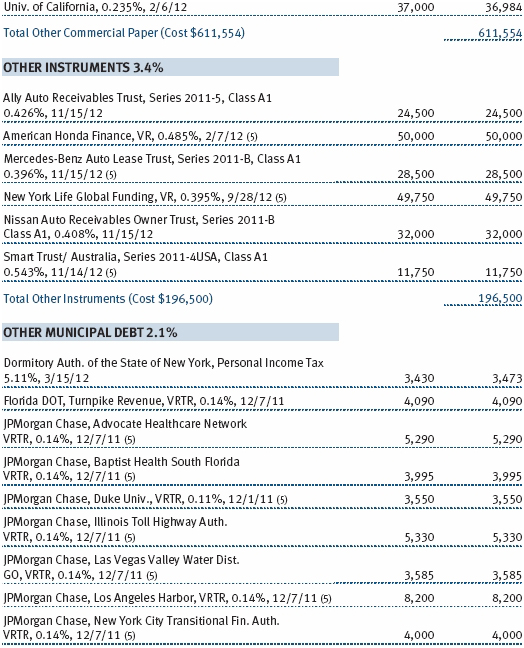
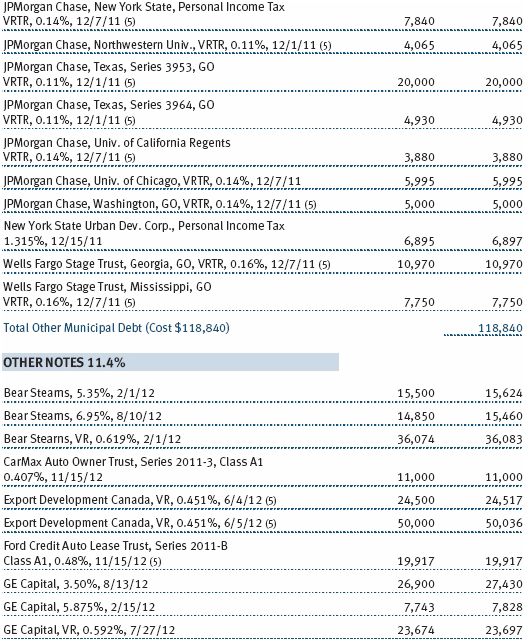
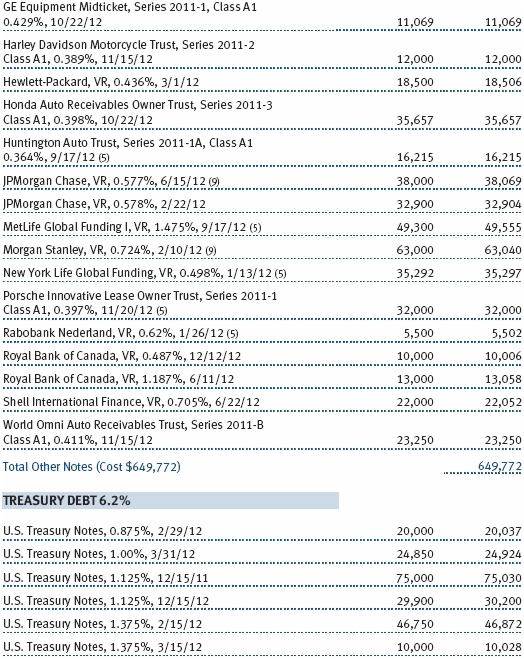

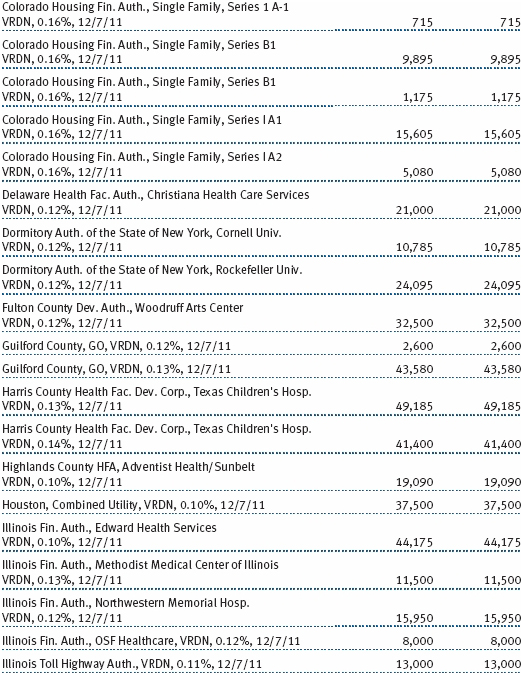
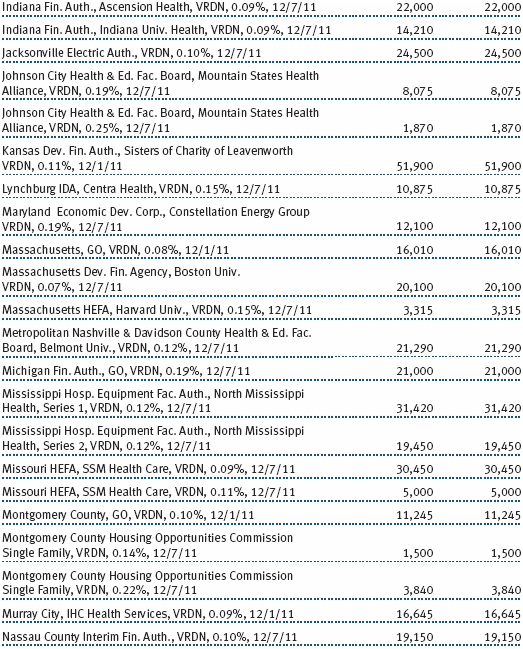
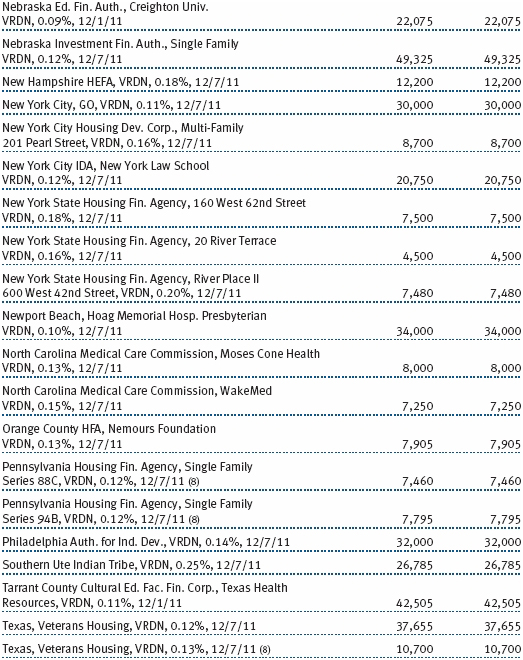
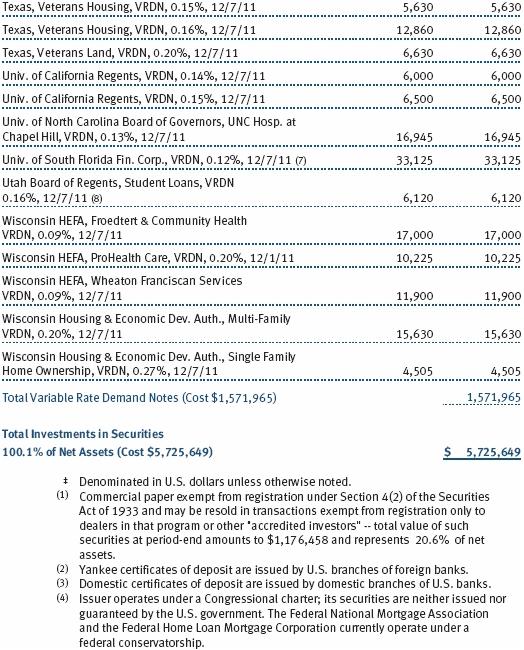
The accompanying notes are an integral part of these financial statements.
Unaudited
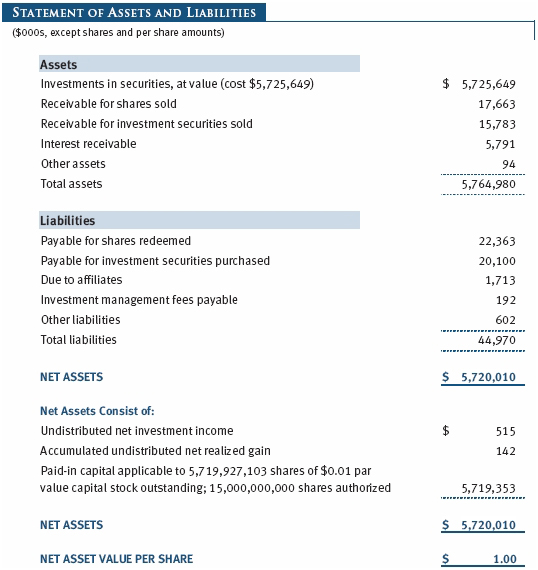
The accompanying notes are an integral part of these financial statements.
Unaudited
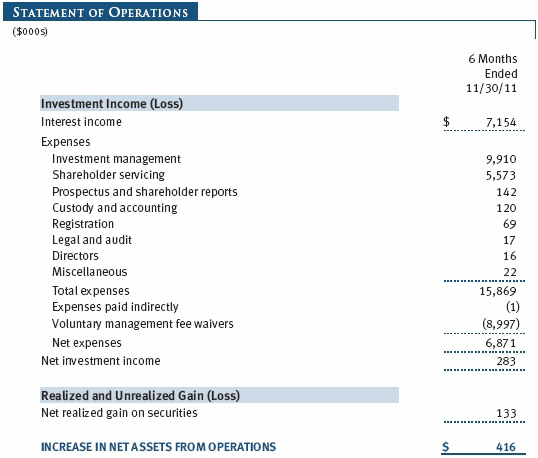
The accompanying notes are an integral part of these financial statements.
Unaudited
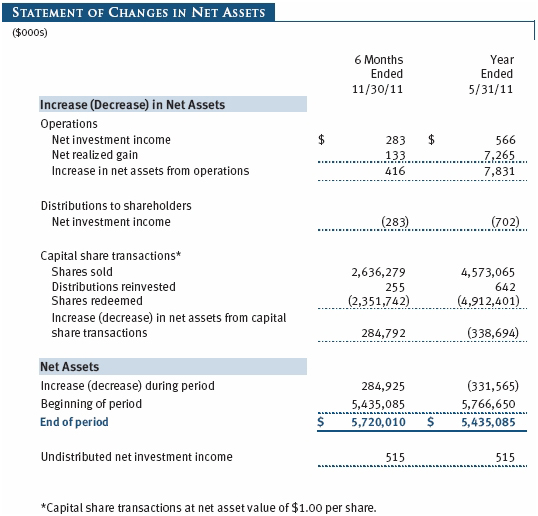
The accompanying notes are an integral part of these financial statements.
Unaudited
| Notes to Financial Statements |
T. Rowe Price Prime Reserve Fund, Inc. (the fund), is registered under the Investment Company Act of 1940 (the 1940 Act) as a diversified, open-end management investment company. The fund commenced operations on January 26, 1976. The fund seeks preservation of capital, liquidity, and, consistent with these, the highest possible current income.
NOTE 1 - SIGNIFICANT ACCOUNTING POLICIES
Basis of Preparation The accompanying financial statements were prepared in accordance with accounting principles generally accepted in the United States of America, which require the use of estimates made by management. Management believes that estimates and valuations are appropriate; however, actual results may differ from those estimates, and the valuations reflected in the accompanying financial statements may differ from the value ultimately realized upon sale or maturity.
Investment Transactions, Investment Income, and Distributions Income and expenses are recorded on the accrual basis. Premiums and discounts on debt securities are amortized for financial reporting purposes. Paydown gains and losses are recorded as an adjustment to interest income. Income tax-related interest and penalties, if incurred, would be recorded as income tax expense. Investment transactions are accounted for on the trade date. Realized gains and losses are reported on the identified cost basis. Distributions to shareholders are recorded on the ex-dividend date. Income distributions are declared daily and paid monthly.
Credits The fund earns credits on temporarily uninvested cash balances held at the custodian, which reduce the fund’s custody charges. Custody expense in the accompanying financial statements is presented before reduction for credits, which are reflected as expenses paid indirectly.
NOTE 2 - VALUATION
The fund values its investments and computes its net asset value per share each day that the New York Stock Exchange is open for business. In accordance with Rule 2a-7 under the 1940 Act, securities are valued at amortized cost, which approximates fair value. Securities for which amortized cost is deemed not to reflect fair value are stated at fair value as determined in good faith by the T. Rowe Price Valuation Committee, established by the fund’s Board of Directors.
Various inputs are used to determine the value of the fund’s financial instruments. These inputs are summarized in the three broad levels listed below:
Level 1 – quoted prices in active markets for identical financial instruments
Level 2 – observable inputs other than Level 1 quoted prices (including, but not limited to, quoted prices for similar financial instruments, interest rates, prepayment speeds, and credit risk)
Level 3 – unobservable inputs
Observable inputs are those based on market data obtained from sources independent of the fund, and unobservable inputs reflect the fund’s own assumptions based on the best information available. The input levels are not necessarily an indication of the risk or liquidity associated with financial instruments at that level. For example, securities held by a money market fund are generally high quality and liquid; however, they are reflected as Level 2 because the inputs used to determine fair value are not quoted prices in an active market. On November 30, 2011, all of the fund’s financial instruments were classified as Level 2, based on the inputs used to determine their values.
NOTE 3 - OTHER INVESTMENT TRANSACTIONS
Consistent with its investment objective, the fund engages in the following practices to manage exposure to certain risks and/or to enhance performance. The investment objective, policies, program, and risk factors of the fund are described more fully in the fund’s prospectus and Statement of Additional Information.
Restricted Securities The fund may invest in securities that are subject to legal or contractual restrictions on resale. Prompt sale of such securities at an acceptable price may be difficult and may involve substantial delays and additional costs.
Repurchase Agreements All repurchase agreements are fully collateralized by U.S. government securities. Collateral is in the possession of the fund’s custodian or, for tri-party agreements, the custodian designated by the agreement. Although risk is mitigated by the collateral, the fund could experience a delay in recovering its value and a possible loss of income or value if the counterparty fails to perform in accordance with the terms of the agreement.
NOTE 4 - FEDERAL INCOME TAXES
No provision for federal income taxes is required since the fund intends to continue to qualify as a regulated investment company under Subchapter M of the Internal Revenue Code and distribute to shareholders all of its taxable income and gains. Distributions determined in accordance with federal income tax regulations may differ in amount or character from net investment income and realized gains for financial reporting purposes. Financial reporting records are adjusted for permanent book/tax differences to reflect tax character but are not adjusted for temporary differences. The amount and character of tax-basis distributions and composition of net assets are finalized at fiscal year-end; accordingly, tax-basis balances have not been determined as of the date of this report.
At November 30, 2011, the cost of investments for federal income tax purposes was $5,725,649,000.
NOTE 5 - RELATED PARTY TRANSACTIONS
The fund is managed by T. Rowe Price Associates, Inc. (Price Associates), a wholly owned subsidiary of T. Rowe Price Group, Inc. (Price Group). The investment management agreement between the fund and Price Associates provides for an annual investment management fee, which is computed daily and paid monthly. The fee consists of an individual fund fee, equal to 0.05% of the fund’s average daily net assets, and a group fee. The group fee rate is calculated based on the combined net assets of certain mutual funds sponsored by Price Associates (the group) applied to a graduated fee schedule, with rates ranging from 0.48% for the first $1 billion of assets to 0.28% for assets in excess of $300 billion. The fund’s group fee is determined by applying the group fee rate to the fund’s average daily net assets. At November 30, 2011, the effective annual group fee rate was 0.30%.
Price Associates may voluntarily waive all or a portion of its management fee to the extent necessary for the fund to maintain a zero or positive net yield (voluntary waiver). Any amounts waived under this voluntary agreement are not subject to repayment by the fund. Price Associates may amend or terminate this voluntary waiver at any time without prior notice. For the six months ended November 30, 2011, management fees waived totaled $8,997,000.
In addition, the fund has entered into service agreements with Price Associates and two wholly owned subsidiaries of Price Associates (collectively, Price). Price Associates computes the daily share price and provides certain other administrative services to the fund. T. Rowe Price Services, Inc., provides shareholder and administrative services in its capacity as the fund’s transfer and dividend disbursing agent. T. Rowe Price Retirement Plan Services, Inc., provides subaccounting and recordkeeping services for certain retirement accounts invested in the fund. For the six months ended November 30, 2011, expenses incurred pursuant to these service agreements were $61,000 for Price Associates; $3,029,000 for T. Rowe Price Services, Inc.; and $907,000 for T. Rowe Price Retirement Plan Services, Inc. The total amount payable at period-end pursuant to these service agreements is reflected as Due to Affiliates in the accompanying financial statements.
As of November 30, 2011, T. Rowe Price Group, Inc., and/or its wholly owned subsidiaries owned 32,204 shares of the fund, representing less than 1% of the fund’s net assets.
NOTE 6 - INTERFUND BORROWING PROGRAM
Price Associates has developed a program that provides temporary liquidity under an interfund borrowing agreement between the fund and other T. Rowe Price-sponsored mutual funds. The program permits the borrowing and lending of cash at rates beneficial to both the borrowing and lending funds. Pursuant to program guidelines, the fund may lend up to 15% of its net assets, and no more than 5% of its net assets may be lent to any one borrower. Loans totaling 10% or more of a borrowing fund’s total assets require collateralization at 102% of the value of the loan; loans of less than 10% are unsecured. During the six months ended November 30, 2011, the fund earned $2,000 in interest income related to loans made to other funds on seven days in the average amount of $10,143,000 and at an average annual rate of 1.10%. At November 30, 2011, there were no loans outstanding.
| Information on Proxy Voting Policies, Procedures, and Records |
A description of the policies and procedures used by T. Rowe Price funds and portfolios to determine how to vote proxies relating to portfolio securities is available in each fund’s Statement of Additional Information, which you may request by calling 1-800-225-5132 or by accessing the SEC’s website, sec.gov. The description of our proxy voting policies and procedures is also available on our website, troweprice.com. To access it, click on the words “Our Company” at the top of our corporate homepage. Then, when the next page appears, click on the words “Proxy Voting Policies” on the left side of the page.
Each fund’s most recent annual proxy voting record is available on our website and through the SEC’s website. To access it through our website, follow the directions above, then click on the words “Proxy Voting Records” on the right side of the Proxy Voting Policies page.
| How to Obtain Quarterly Portfolio Holdings |
The fund files a complete schedule of portfolio holdings with the Securities and Exchange Commission for the first and third quarters of each fiscal year on Form N-Q. The fund’s Form N-Q is available electronically on the SEC’s website (sec.gov); hard copies may be reviewed and copied at the SEC’s Public Reference Room, 450 Fifth St. N.W., Washington, DC 20549. For more information on the Public Reference Room, call 1-800-SEC-0330.
Item 2. Code of Ethics.
A code of ethics, as defined in Item 2 of Form N-CSR, applicable to its principal executive officer, principal financial officer, principal accounting officer or controller, or persons performing similar functions is filed as an exhibit to the registrant’s annual Form N-CSR. No substantive amendments were approved or waivers were granted to this code of ethics during the registrant’s most recent fiscal half-year.
Item 3. Audit Committee Financial Expert.
Disclosure required in registrant’s annual Form N-CSR.
Item 4. Principal Accountant Fees and Services.
Disclosure required in registrant’s annual Form N-CSR.
Item 5. Audit Committee of Listed Registrants.
Not applicable.
Item 6. Investments.
(a) Not applicable. The complete schedule of investments is included in Item 1 of this Form N-CSR.
(b) Not applicable.
Item 7. Disclosure of Proxy Voting Policies and Procedures for Closed-End Management Investment Companies.
Not applicable.
Item 8. Portfolio Managers of Closed-End Management Investment Companies.
Not applicable.
Item 9. Purchases of Equity Securities by Closed-End Management Investment Company and Affiliated Purchasers.
Not applicable.
Item 10. Submission of Matters to a Vote of Security Holders.
Not applicable.
Item 11. Controls and Procedures.
(a) The registrant’s principal executive officer and principal financial officer have evaluated the registrant’s disclosure controls and procedures within 90 days of this filing and have concluded that the registrant’s disclosure controls and procedures were effective, as of that date, in ensuring that information required to be disclosed by the registrant in this Form N-CSR was recorded, processed, summarized, and reported timely.
(b) The registrant’s principal executive officer and principal financial officer are aware of no change in the registrant’s internal control over financial reporting that occurred during the registrant’s second fiscal quarter covered by this report that has materially affected, or is reasonably likely to materially affect, the registrant’s internal control over financial reporting.
Item 12. Exhibits.
(a)(1) The registrant’s code of ethics pursuant to Item 2 of Form N-CSR is filed with the registrant’s annual Form N-CSR.
(2) Separate certifications by the registrant's principal executive officer and principal financial officer, pursuant to Section 302 of the Sarbanes-Oxley Act of 2002 and required by Rule 30a-2(a) under the Investment Company Act of 1940, are attached.
(3) Written solicitation to repurchase securities issued by closed-end companies: not applicable.
(b) A certification by the registrant's principal executive officer and principal financial officer, pursuant to Section 906 of the Sarbanes-Oxley Act of 2002 and required by Rule 30a-2(b) under the Investment Company Act of 1940, is attached.
SIGNATURES
Pursuant to the requirements of the Securities Exchange Act of 1934 and the Investment Company Act of 1940, the registrant has duly caused this report to be signed on its behalf by the undersigned, thereunto duly authorized.
T. Rowe Price Prime Reserve Fund, Inc.
| By | /s/ Edward C. Bernard |
| Edward C. Bernard |
| Principal Executive Officer |
| |
| Date | January 23, 2012 |
Pursuant to the requirements of the Securities Exchange Act of 1934 and the Investment Company Act of 1940, this report has been signed below by the following persons on behalf of the registrant and in the capacities and on the dates indicated.
| By | /s/ Edward C. Bernard |
| Edward C. Bernard |
| Principal Executive Officer |
| |
| Date | January 23, 2012 |
| |
| |
| By | /s/ Gregory K. Hinkle |
| Gregory K. Hinkle |
| Principal Financial Officer |
| |
| Date | January 23, 2012 |



























